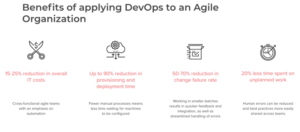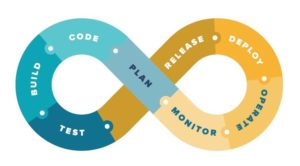What do improved quality, faster time to market, and reduced costs have in common? They are all benefits of applying DevOps principles to the software development process.
“The global DevOps market size is expected to reach USD $12.85 billion by 2025, according to Grand View Research.”
Unlike most of today’s tech crazes, DevOps is not a single product or technology; it is a methodology or a set of principles that are designed to improve collaboration between teams, aligning them toward a single shared objective.
DevOps is an extension of the Agile methodology aimed at eliminating the workflow barriers that exist when development (dev) and operations (ops) work in separate silos. By increasing collaboration and removing these operational challenges, DevOps enables rapid, continuous delivery of a software product. This means that multiple updates and iterations can be deployed within hours, as opposed to days or weeks.
Media streaming giant Netflix is a great example. Although its multi-device platforms attract nearly one-third of all internet traffic, Netflix’s DevOps team is less than 100 strong. When you consider the number of updates Netflix needs to put out, this shows just how efficient the practice can be when done right.
DevOps was originally meant to increase and improve trust between dev and ops teams. Now, it’s about helping all teams become leaner, more integrated, and more self-sufficient, which requires a cultural shift across the entire organization. However, many companies are not ready or willing to make this change, regardless of how attractive the benefits may seem.
In reality, not every company can pull off the high level of commitment, resources, investment, and stakeholder buy-in that DevOps requires, so it’s vital to asses these aspects before jumping in headfirst.
The DevOps Workflow
There’s no doubt that Agile and Lean methodologies have been indispensable for modern software development teams. The benefit of DevOps is that it extends the same principles to the operations team, making deployment much faster and more integrated with the development process.
Automated QA testing is where DevOps really shines. Products used to be built in a development environment before being handed off to operations and QA to test in production (where they often failed). With DevOps, production environment infrastructure can be simulated in the cloud, where automation is then used to test the code before it’s reviewed and released.
“Every stage of the DevOps workflow can be sped up with automation tools, which are central to the philosiphy of process improvement.”
In fact, every stage in the DevOps workflow (see below) can be sped up using automation tools, which are central to the whole philosophy of process improvement. This extends to simulated data sets, which are generated synthetically to avoid security incidents or customer privacy data breaches. Test engineers are also engineering the systems that automatically test the software, reducing manual work and allowing testers to adopt higher-value roles in the organization.
Check out our DevOps team’s favorite Continuous Integration tools here.
The DevOps workflow is deceptively simple. For each project, feature, or iteration, the developer first plans how to develop the software before coding with tools like Git. Next, the code is built and made executable with tools like Gradle or Maven, before being tested for any bugs and released to operations, when it is deployed and configured using tools like Ansible or Docker. At this stage, the product is operated and monitored for any issues, which are immediately reported back to development for the next planning phase. And so the workflow begins anew!
With both teams working side by side, developers can build software products that are immediately and simultaneously tested by operations, resulting in a common mindset, shared ideas, and much faster delivery. Combine that with automation and the risk of moving so rapidly is mitigated.
Amplified Feedback Loops
Operations teams have traditionally been associated with watching systems and infrastructure, whereas now they have to think about application delivery. This is helped by automating software delivery processes and any changes to infrastructure, but still requires solid communication with the dev team at all stages in the workflow.
With Agile, software is rarely—if ever—built and tested in the final production environment. For operations teams, this creates a challenge, as the product is unlikely to work when it’s first deployed.
With DevOps, solutions are built out and tested in a production-like environment, giving them a chance to analyze the production environment and tell developers what works and what doesn’t. This feedback gives developers insight into how the product or feature is performing so they can prioritize what to work on next, allowing them to become far more agile and responsive to issues.
This feedback is also used to improve the overall software delivery process, by reducing the amount of work repetition and the cost of overheads. The results are higher quality products within a much shorter turnaround.
Shifting Toward a DevOps Culture
True DevOps culture is achieved when companies are positioned to continuously change and innovate. Like any cultural shift within a company, it takes a long time to reach that position, especially when legacy systems and processes are deeply ingrained.
“DevOps is not just about hiring DevOps engineers; it’s about driving a company culture of trust, education, experimentation, and innovation.”
Early adopters and supporters of DevOps can expedite this by educating stakeholders on its benefits, while also communicating how it can enhance the company’s digital transformation efforts. At the team level, staffers who are resistant to change may find it difficult to move away from tried-and-tested methods. It’s best to start with a small pilot to demonstrate how new tools and increased team alignment can improve their workflow and their team spirit.
Once the imaginary wall between the development and IT operations teams has been toppled, the ripple effect will be felt throughout the whole company, so it’s vital for everyone to be prepared.
Adopting DevOps within an organization is challenging, but Wizeline has determined three core principles that help guide the process.
- The first is giving teams a high degree of flow, which allows them to constantly deliver value to end users without obstacles or restraints.
- Secondly, feedback loops should be amplified, meaning that development teams are informed about user or stakeholder feedback when they make a change.
- Finally, the DevOps philosophy is all about continuously improving processes, so DevOps teams need to be empowered to constantly learn and experiment in order to achieve this. This approach also helps to retain valuable talent.
For many companies, the autonomy that DevOps teams need to thrive is the biggest and most difficult barrier to overcome. Staff hierarchies are still common in most companies, so flattening that out and allowing teams to operate without the usual checks and balances is difficult.
While DevOps has been around since 2009 it is still in its infancy, meaning that DevOps professionals are hard to come by and expensive. Still, DevOps is not just about hiring DevOps engineers; it’s about forming a company culture that is driven by trust, education, experimentation, and innovation.
Without committing to these elements, DevOps teams cannot increase the value they bring to the business. Period.









